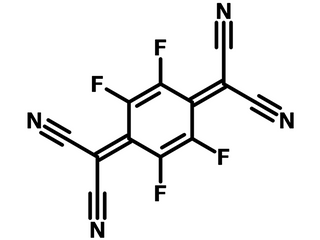F4TCNQ
CAS Number 29261-33-4
Charge Transport Layer Materials, High Purity Sublimed Materials, Hole Injection Layer Materials, Hole Transport Layer Materials, Materials, OLED Materials,F4TCNQ, most effective p-type dopant with a deep LUMO level
High-purity and available online for priority dispatch, 2,3,5,6-Tetrafluoro-7,7,8,8-tetracyanoquinodimethane, CAS No. 29261-33-4, Sublimed ≥99.0%
Overview | Specifications | Pricing and Options | Literature and Reviews
F4TCNQ, CAS number 29261-33-4, is one of the most widely used and most effective p-type dopants due to its strong electron-accepting ability and the extended π system. It has a deep LUMO level (-5.2 eV) which is energetically in the vicinity of the HOMO level of many organic semiconductors. Doping is facilitated by charge transfer from the HOMO level of the host to the LUMO of the dopant molecule. Pin devices with F4TCNQ doped 4,4',4''-tris(3-methylphenylphenylamino)triphenylamine (m-MTDATA) serving as the p-doped HTL show high luminance and efficiency at extremely low operating voltages: For instance, a luminance of 1000 cd/m2 is reached at a voltage of 2.9 V [1].
F4TCNQ from Ossila was used in the high-impact paper (IF 18.81), High Seebeck Coefficient in Mixtures of Conjugated Polymers, G. Zuo et al., Adv. Funct. Mater., 1703280 (2017); DOI: 10.1002/adfm.201703280.
It has been reported that by controlling the doping concentration, the PCE of the PCDTBT:F4TCNQ solar cells increased from 6.41% to 7.94%, mainly due to improving the photocurrent with a F4TCNQ weight ratio of the blend lower than 0.5% [2]. F4TCNQ is also used as the p-type dopant for graphenes [3,4].
General Information
| CAS number | 29261-33-4 |
|---|---|
| Chemical formula | C12F4N4 |
| Molecular weight | 276.15 g/mol |
| HOMO/LUMO | HOMO = 8.3 eV, LUMO = 5.2 eV |
| Synonyms |
|
| Classification / Family | Fluorinated compounds, p-type dopant, Strong electron acceptor, Hole-injection materials, Hole-transport layer material, OLEDs, Polymer Solar Cells, Perovskite Solar Cells, OFETs. |
Product Details
| Purity | >99% (sublimed) |
|---|---|
| Melting point | 291 °C (DSC onset) |
| Appearance | Brown-yellow powder |
*Sublimation is a technique used to obtain ultra pure-grade chemicals. For more details about sublimation, please refer to the Sublimed Materials.
Chemical Structure

| Device structure | ITO/m-MTDATA*:F4-TCNQ (100 nm)/TPD (5 nm)/Alq3 (20 nm) /BPhen (10 nm)/ Bphen:Li (30 nm)/LiF (1 nm)/Al (100 nm) [1] |
|---|---|
| Color | Green |
| Luminance | 1,000 cd/m2 at 2.9 V (high brightness at low operating voltage) |
| Max. Current Efficiency | 5.27 cd/A |
| Device structure | ITO/MeO-TPD*:F4-TCNQ (100 nm)/Spiro-TAD (10 nm)/TCTA:Ir(ppy)3 (5 nm)/BPhen (10 nm)/Cs-doped BPhen (50 nm)/Al [5] |
|---|---|
| Color | Green |
| Max. EQE | 13.7% |
| Max. Power Efficiency | 52 lm W−1 |
| Device structure | ITO/0.4 wt% F4TCNQ doped α NPD (30 nm)/ 5 wt% Ir(ppy)3 doped CBP (50 nm)/BPhen (30 nm)/20 wt% TCNQ mixed BPhen (1.5 nm)/Al [6] |
|---|---|
| Color | Green |
| Luminance@15 V | 1,320 cd/m2 |
| Power Efficiency@14 V | 56.6 lm W−1 |
| Current Efficiency@14 V | 23.17 cd/A |
| Device structure | ITO/F4TCNQ (3 nm)/MeO-Spiro-TPD (27 nm)/CBP + BCzVbi* (50 nm)/BPhen (10 nm)/TCNQ mixed BPhen (1.5 nm)/Al [7] |
|---|---|
| Color | Red |
| Luminance@ 10 mA/cm2 | 1,790 cd/m2 |
| Power Efficiency@ 10 mA/cm2 | 4.65 lm W−1 |
| Current Efficiency@ 10 mA/cm2 | 18.0 cd/A |
| Device structure | ITO/MeO-TPD: F4-TCNQ (100 nm, 4%)/NPB (15 nm)/CBP: (MPPZ)2Ir(acac) (25 nm, 8.5%)/CBP (4 nm)/CBP: DSA-ph (20 nm, 3%)/ETLs (30 nm)/LiF (1 nm)/Al (200 nm) [8] |
|---|---|
| Color | White |
| Max. Luminance | 97,067 cd/m2 |
| Max. Current Efficiency | 42.8 cd/A |
| Max. Power Efficiency | 21.1 lm W−1 |
| Device structure | ITO (120 nm)/0.4 wt. % F4-TCNQ:α-NPD (35 nm)/5 wt. % BCzVBi:CBP (20 nm)/ 5 wt. % Ir(ppy)3:CBP (4 nm)/0.75 wt. % Ir(btp)2acac:CBP (12.5 nm)/BAlq (30 nm)/LiF (1 nm)/Al (150 nm) [9] |
|---|---|
| Color | White |
| Max. Luminance | 106,100 cd/m2 |
| Max. Current Efficiency | 50.3 cd/A |
| Max. Power Efficiency | 26.3 lm W−1 |
| Device structure | ITO/PTAA/ CH3NH3PbI3/PCBM/C60/BCP/Ag [10] | ITO/PTAA:F4TCNQ (1 wt%)/CH3NH3PbI3/PCBM/C60/BCP/Ag [10] |
|---|---|---|
| Jsc (mA cm-2) | 21.6 | 21.6 |
| Voc (V) | 1.05 | 1.09 |
| FF (%) | 65.7 | 74 |
| PCE (best) | 14.8 | 17.5 |
*For chemical structure information, please refer to the cited references.
Characterization

Pricing
| Grade | Order Code | Quantity | Price |
|---|---|---|---|
| Sublimed (>99% purity) | M351 | 100 mg | £105 |
| Sublimed (>99% purity) | M351 | 250 mg | £230 |
| Sublimed (>99% purity) | M351 | 500 mg | £360 |
| Sublimed (>99% purity) | M351 | 1 g | £580 |
| Sublimed (>99% purity) | M351 | 5 g | £2400 |
| Sublimed (>99% purity) | M351 | 10 g | £4200 |
Literature and Reviews
- Low-voltage organic electroluminescent devices using pin structures, J. Huang et al., Appl. Phys. Lett. 80, 139 (2002); https://dx.doi.org/10.1063/1.1432110.
- Molecular Doping Enhances Photoconductivity in Polymer Bulk Heterojunction Solar Cells, Y. Zhang et al., Adv. Mater., 25, 7038–7044 (2013).
- Band Gap Opening of Bilayer Graphene by F4-TCNQ Molecular Doping and Externally Applied Electric Field, X. Tian et al., J. Phys. Chem. B, 114 (35), 11377–11381 (2010).
